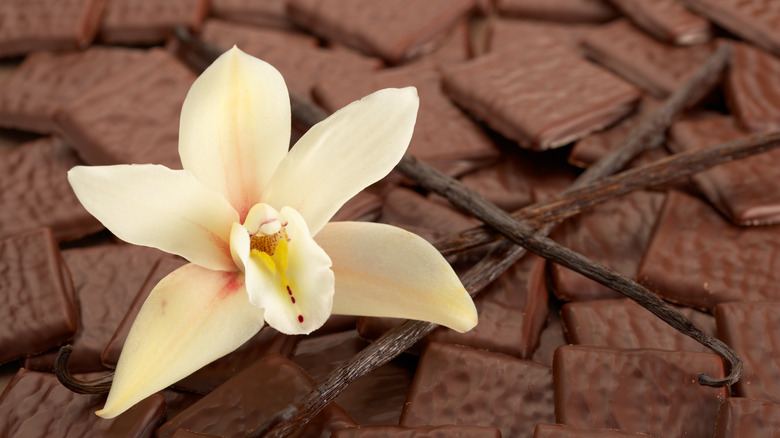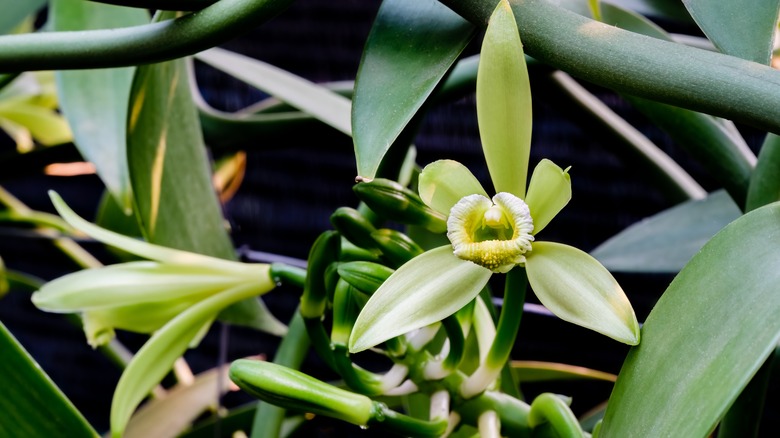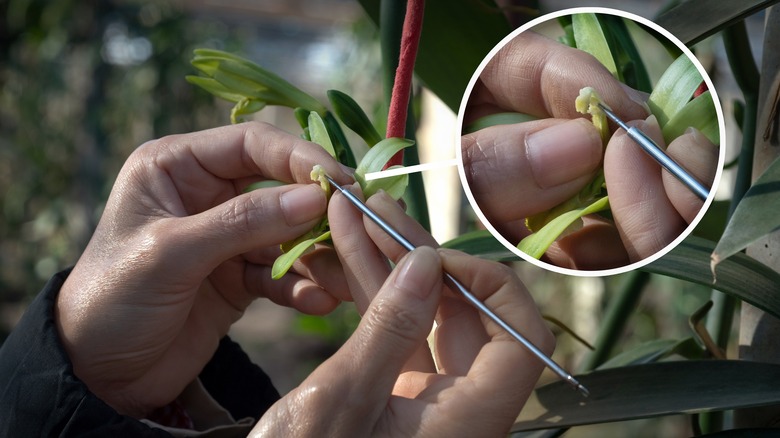The Stunning Orchid That Produces Vanilla Beans (& Plant Care Mistakes To Avoid)
Did you know that globally, less than 1% of vanilla flavoring is actually derived from the vanilla orchid plant? While vanilla is one of the most common kitchen spices, it wasn't always that way. Vanilla used to be one of the most sought-after and rare spices in the world. In addition, most people are unaware that vanilla comes from an orchid native to the rainforests of Central America. The distinctive aroma and taste are more than just your favorite flavor of ice cream or perfume. It has a long and fascinating history that took this orchid and its seed pods all over the world.
It turns out, this unique orchid (like most orchids) is not the easiest to care for. It can take years to get a harvest, and the flowers must be hand-pollinated when grown outside of their native range. However, it is entirely possible to grow your own vanilla orchid. Aside from creating the right growing conditions to keep your vanilla orchid happy and healthy, patience is one of the most important virtues to embody. Growing the vanilla orchid is not an instant gratification gardening project, and it's not like starting any annual veggies from seed, either. This gorgeous, ancient plant requires patience, dedication, and special attention. If you're planning on growing this beauty indoors, knowing how to grow orchids indoors successfully will go a long way. For outdoor growing, you'll need to live in a hot climate.
What is a vanilla orchid?
A vanilla orchid is the gorgeous vining plant behind the famous vanilla spice. Second to saffron, vanilla is one of the most expensive spices in the world due to the labor-intensive harvesting process and the time it takes to produce a yield. A vining, semi-epiphytic orchid native to the humid and bountiful rainforests of Central and South America, this stunning orchid can reach lengths of 100 feet! The vanilla orchid is unique for many reasons. However, specifically, its vining growth habit is unique for an orchid plant and lends to its surreal beauty.
Cultivated and honored for millennia by the Totonac people native to Vera-Cruz, Mexico, the vanilla orchid is known to have significance to the pre-Columbian Mayan people and was used in sacred cacao ceremonies. During the early phases of European colonization in Central and South America, the Aztecs introduced Spanish conquistadors to the vanilla orchid. Shortly after, in true conquistador fashion, they took the orchid out of its home in the jungle and brought it to Europe. In Europe, alongside cacao, it became a super rare, expensive, and coveted luxury item that only the extraordinarily wealthy could afford. While vanilla is still one of the most costly spices in the world, thankfully, it is much more widely accessible than it once was. Especially since it is now being artificially simulated, most of the vanilla we purchase in stores is made in a lab — all the more reason to grow your own!
How to grow and care for the vanilla orchid and what to avoid
Not only is vanilla more readily available for the everyday shopper to purchase but nowadays, people can grow their own vanilla orchids! That's right. This gorgeous, aromatic, highly sought-after spice is well within your green thumb's reach. As mentioned briefly above, the vanilla orchid differs slightly from your traditional orchid as it is a semi-epiphytic. It's the halfway point between an epiphytic orchid (an orchid that does not grow in soil but gets its nutrients from the air and water) and a terrestrial orchid that grows in soil like most plants. Furthermore, it can be grown as an epiphyte or in the ground.
The most common mistakes people make when growing the vanilla orchid are pretty standard orchid care mistakes. Inadequate lighting, low humidity, poor airflow and circulation, overwatering, or underwatering are all common orchid killers that will also kill your vanilla orchid. In addition to your common orchid mistakes, the vanilla orchid has some special requirements. As it is a vining orchid, it needs some sort of trellising or support to allow it to climb. Additionally, in their native range, vanilla orchids are pollinated by hyper-specific and specialized pollinators that have evolved with this orchid for thousands of years. Furthermore, if you want a vanilla bean harvest, you have to hand pollinate your orchid flowers by gently transferring pollen from one stigma to another using a Q-tip or small brush.


